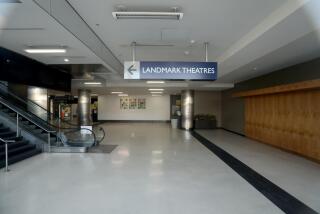Recovery Channel to the Rescue Following Quake : Television: FEMA launched the satellite-generated broadcasts to aid communication during natural disasters.
- Share via
One of the unexpected results of the Jan. 17 earthquake is a new television channel.
It’s called the Recovery Channel, and it represents the Federal Emergency Management Agency’s (FEMA) most ambitious use of television to distribute information to assist those impacted by a natural disaster.
The Recovery Channel provides round-the-clock programming--mostly computer-generated announcements but also field reports, interviews and the daily news briefings on recovery efforts by FEMA and the California Office of Emergency Services. It also provides reports in Spanish and Korean and plans to expand its computer-generated announcements into Spanish once a translator can be found.
The channel can be seen at disaster assistance sites and recovery offices, and is also carried at times on KLCS-TV Channel 58 and on LA CityView35, the government-access channel on cable systems within Los Angeles’ city limits.
The programming began Jan. 21 and will continue “as long as we feel it is providing a service,” said Phil Cogan, the acting deputy director of the Office of Emergency Information and Public Affairs, a branch of FEMA.
Planning for the broadcasts began when Cogan arrived in the Southland the evening of Jan. 17.
FEMA decided to use satellite-delivered television as a tool after being disappointed with the way information was conveyed following Hurricane Andrew, which hit southern Florida in 1992. Its first use came last summer for the Midwest flooding, with the broadcasts being done a few hours a day from the agency’s Washington headquarters. A similar plan was used for Hurricane Emily.
This is the first time the agency has broadcast from the location of a disaster, Cogan said.
The channel is operating out of a Pasadena office building, using the corner of a sixth-floor office as a makeshift studio, where interviews are conducted. Its approximately 20-person staff has mainly been culled from government agencies.
The programming is distributed to the various cable systems via a satellite dish atop a television production truck parked outside the office. Satellite time has been rented on both the C and KU bands for $177,000 a month--a 50% reduction from the normal cost, Cogan said.
“We feel it has cut costs (from a disaster) because information is getting out faster,” said James Lee Witt, FEMA director, who also pointed out that the service frees workers from having to repeatedly answer the same questions by telephone and reduces demand on the telephone lines. “It cuts time, and in a case like this, time is money.”
In the past two days, the Recovery Channel has interviewed an official from the state Contractors License Board, warning of fraudulent practices and offering tips on how to avoid them, talked with a man entertaining children who had been left homeless and scared by the earthquake and reported from a staging area in Los Alamitos, where water and food are being distributed.
More to Read
Sign up for Essential California
The most important California stories and recommendations in your inbox every morning.
You may occasionally receive promotional content from the Los Angeles Times.










